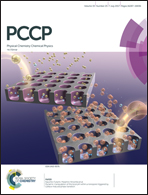Room temperature sintering of polar ZnO nanosheets: II-mechanism†
Abstract
In a previous work by the authors (A. Fernández-Pérez el al., Room temperature sintering of polar ZnO nanosheets: I-evidence, 2017, DOI: 10.1039/C7CP02306E), polar ZnO nanosheets were stored at room temperature under different atmospheres and the evolution of their textural and crystal properties during storage was followed. It was found that the specific surface area of the nanosheets drastically decreased during storage, with a loss of up to 75%. The ZnO crystals increased in size mainly through the partial merging of their polar surfaces at the expense of narrow mesoporosity, in a process triggered by the action of moisture, oxygen and, in their absence, by light. In the present work, a set of spectroscopic techniques (FTIR, Raman and XPS) has been used in an attempt to unravel the mechanism behind this spontaneous sintering process. The mechanism starts with the molecular adsorption of water, which takes place on Zn atoms close to oxygen vacancies on the (100) surface, where H2O dissociates to form two hydroxyl groups and to heal one oxygen vacancy. This process triggers the room temperature migration of Zn interstitials towards the outer surface of the polar region. What were previously interstitial Zn atoms now gradually occupy the mesopores, with interstitial oxygen being used to build up the O sublattice until total occupancy of the narrow mesoporosity is achieved.

- This article is part of the themed collection: 2017 PCCP HOT Articles


 Please wait while we load your content...
Please wait while we load your content...